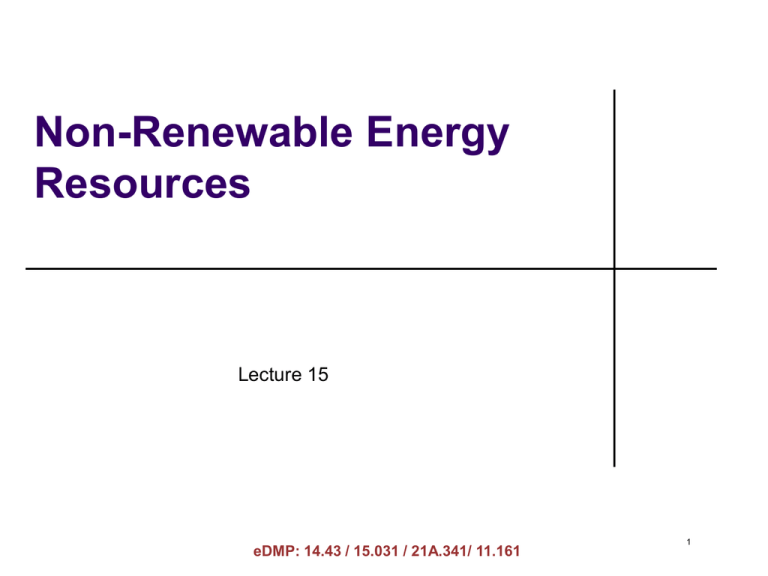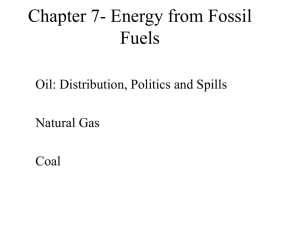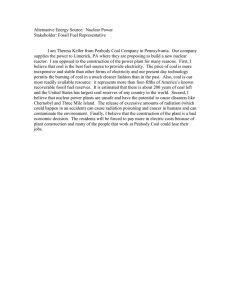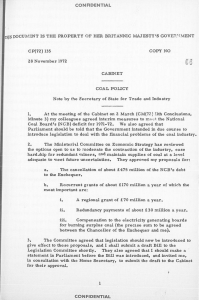
Non-Renewable Energy
Resources
Lecture 15
eDMP: 14.43 / 15.031 / 21A.341/ 11.161
1
Non-Renewable Resources: 92% of US Primary Energy
© Lawrence Livermore National Laboratory. All rights reserved. This content is excluded from
our Creative Commons license. For more information, see http://ocw.mit.edu/fairuse.
2
Also 92% of World Marketed Primary Energy
World consumption
Million tonnes oil equivalent
13000
Coal
Renewables
Hydroelectricity
Nuclear energy
Natural gas
Oil
12000
11000
10000
9000
8000
7000
6000
5000
4000
3000
2000
1000
86
87
88
89
90
91
92
93
94
95
96
97
98
99
00
01
02
03
04
05
06
07
08
09
10
11
World primary energy consumption grew by 2.5% in 2011, less than half the growth rate experienced in 2010 but close to the historical average. Growth decelerated for
all regions and for all fuels. Oil remains the world’s leading fuel, accounting for 33.1% of global energy consumption, but this figure is the lowest share on record. Coal’s
market share of 30.3% was the highest since 1969.
Courtesy of BP Statistical Review of World Energy June 2012. Used with permission.
3
0
Non-Renewables Likely Dominant for Many More Decades
Source: Koonin, Steven. E. What’s Next in Energy? U.S. Energy Information Administration.
4
Topics
• Economic theory of non-renewable resources
Classic Hotelling theory
Recent advances & implications
• Some basic facts about the markets for
Petroleum
Coal
Uranium
Natural gas, Part 1
5
Classic Hotelling Theory: The Timing Decision
• Suppose you own a well containing exactly 1,000 barrels
of oil. Each barrel can be produced for $30. You have
complete flexibility as to when to produce the oil.
Currently the price of oil is $80 per barrel.
• If you knew future oil prices, how would you decide when
to produce your oil?
Pick t (or ts) to max discounted net revenue: (Pt – MC)/(1 + R)t
• If all the oil in the world is produced from oil wells exactly
like yours, what will happen to the price of oil?
(Pt – MC)/(1 + R)t = (P0 – MC) > 0; (P – MC) rises at interest rate
If LHS < RHS, raise output today, which lowers today’s price…
Note: P > MC despite competition; today’s output lowers later
revenue; there is an opportunity cost of producing today
6
Classic (Hotelling) Theory II
PT
PT
Price
Price
Demand
P0
P0
P-c
C
C
Time
(a)
T
Marginal Extraction
Cost
Quantity
Q0
(b)
Image by MIT OpenCourseWare.
• Under those assumptions, when should you produce your oil?
Doesn’t matter
• What if a monopoly has 99.5% of all oil, MC = $30?
(MR – MC) rises at rate R; P typically rises more slowly, so
produce NOW
7
But Prices of Non-Renewables Don’t Rise Smoothly!
Crude oil prices 1861-2011
US dollars per barrel
World events
Yom Kippur war
Post-war reconstruction
Fears of shortage in US
Growth of Venezuelan
production
Russian
oil exports
began
Pennsylvanian
oil boom
East Texas field
discovered
Discovery of
Sumatra
production Spindletop,
Texas
began
Iranian revolution
Loss of Iranian
supplies
Netback pricing
introduced
Suez crisis
Iraq
invaded
Kuwait
Asian financial crisis
Invasion
of Iraq
‘Arab
Spring’
120
110
100
90
80
70
60
50
40
30
20
10
1861-69
1870-79
1880-89
1890-99
1900-09
1910-19
1920-29
1930-39
1940-49
1950-59
1960-69
1970-79
$ 2011
$ money of the day
Courtesy of BP Statistical Review of World Energy June 2012. Used with permission.
1980-89
1990-99
2000-09
2010-19
1861-1944 US average.
1945-1983 Arabian Light posted at Ras Tanura.
1984-2011 Brent dated.
8
0
What’s Missing from the Classic Theory?
• Exploration: Reserves are an inventory; decisions to search, to
prove, & to drill are intertemporal choices, like classic model.
End 1976 to end 2009, US proved reserves 10.26 B bbl.; production?
Production during that period was 78.45 B bbl.
• Depletion: Costs of finding, extracting likely to rise as more is
produced from any given area (e.g., US).
• Innovation: Technologies for finding, extracting improve over time –
a race with depletion.
• Uncertainty: Future demand, supply are not known.
• SR Inflexibility: Simple model over-states flexibility in output choice
– little SR supply flex for oil + inelastic demand SR P volatility.
• Cartel Behavior: OPEC behavior is complicated
• Politics: Why else drill miles deep, miles offshore when it is much
cheaper to produce in the Middle East?
9
Basic Market Facts: Oil
• Transport (pipelines, ships) relatively cheap; market
has been global (single pool) since at least 1970s
Active spot and futures markets, with good data; the latter
used for hedging and speculation
• Production is concentrated geographically, reserves
even more so; much of both in unstable nations
• OPEC is a cartel of the big (national) oil firms, power
has varied; Saudi Arabia has historically been the
main holder of excess capacity
• As we have seen, price has been volatile since the
1973-74 embargo
10
International Oil Trade: 65% of Production
Major trade movements 2011
Trade flows worldwide (million tonnes)
23.7
2
298.2
29.5
48.6
35.5
133.8
133
3
12
26.0
57.6
175.1
51
5.1
68.3
27.1
18.4
59.8
49
5
49.5
28.4
28
28.4
4
13
1
137
137.8
37
95.5
41.1
61.1
26..0
.0
111.2
28.4
110.
0.
0.7
22.1
61.5
226.6
34.3
US
Canada
Mexico
S. & Cent. America
Europe & Eurasia
Middle East
Africa
Asia Pacific
15.6
29.5
42.2
27.1
Courtesy of BP Statistical Review of World Energy June 2012. Used with permission.
11
Middle East: 30% of World Production
Production by region
Million barrels daily
100
Asia Pacific
Africa
Middle East
Europe & Eurasia
S. & Cent. America
North America
90
80
70
60
50
40
30
20
10
86
91
96
01
06
11
0
Courtesy of BP Statistical Review of World Energy June 2012. Used with permission.
12
Middle East: Over Half of Proved Reserves
Distribution of proved reserves in 1991, 2001 and 2011
Percentage
Middle East
Europe & Eurasia
Asia Pacific
Africa
North America
S. & Cent. America
3.6
38.4
5.2
4.2
7.0
42.1
4.6
4.0
7.8
32.6
8.0
7.2
7.7
7.2
7.1
1991
Total 131.2
trillion cubic
metres
2001
Total 168.5
trillion cubic
metres
2011
Total 208.4
trillion cubic
metres
41.8
37.8
33.7
Courtesy of BP Statistical Review of World Energy June 2012. Used with permission.
13
OPEC’s Share of World Output Has Varied
14
The Big Oil/Gas Companies are National
Companies ranked in order of 2007 worldwide oil equivalent oil/gas reserves as
reported in "OGJ 200/100", Oil & Gas Journal, September 15, 2008.
Courtesy of Oil & Gas Journal. Used with permission.
15
Basic Market Facts: Coal
• Reserves, production concentrated in a few leading
nations in several regions
• Mainly moved by rail and ship; high weight-to-value
ratio limits trade
• Markets tend to be mainly national; US has abundant
supplies, relatively low prices, regional differences
• Long-term contracts dominate; spot and (since 2001)
futures markets less important
• Huge recent increase in Chinese use of coal
16
Production, Reserves Fairly Concentrated
2010, Pct. of World
Output Reserves
China
48.3
13.3
United States
14.8
27.6
Australia
6.3
8.9
India
5.8
7.0
Russia
4.0
18.2
Total
79.2
75.0
17
Coal Exports: 15% of Production
Leading Exporters, 2010
Country
Share
Australia
27.1
Indonesia
26.1
Russia
10.1
U.S.
6.9
Leading Importers, 2010
Country
Share
Japan
17.5
China
16.6
S. Korea
10.7
India
8.6
18
Prices Differ; Not a Global Market
US dollars per tonne
Northwest Europe market
price
US Central Appalachian
coal spot price index
Japan coking coal import
cif price
Japan steam coal import
cif price
1990
43.48
31.59
60.54
50.81
1991
42.80
29.01
60.45
50.30
1992
38.53
28.53
57.82
48.45
1993
33.68
29.85
55.26
45.71
1994
37.18
31.72
51.77
43.66
1995
44.50
27.01
54.47
47.58
1996
41.25
29.86
56.68
49.54
1997
38.92
29.76
55.51
45.53
1998
32.00
31.00
50.76
40.51
1999
28.79
31.29
42.83
35.74
2000
35.99
29.90
39.69
34.58
2001
39.03
50.15
41.33
37.96
2002
31.65
33.20
42.01
36.90
2003
43.60
38.52
41.57
34.74
2004
72.08
64.90
60.96
51.34
2005
60.54
70.12
89.33
62.91
2006
64.11
62.96
93.46
63.04
2007
88.79
51.16
88.24
69.86
2008
147.67
118.79
179.03
122.81
2009
70.66
68.08
167.82
110.11
2010
92.50
71.63
158.95
105.19
*Source: McCloskey Coal Information Service. Prices fo 1990-2000 are the average of the monthly marker, 2001-2010 the average of weekly prices.
**Source: Platts. Prices are for CAPP 12,500Btu, 1.2 SO2 coal, fob. Prices for 1990-2000 are by coal price publication date, 2001-2010 by coal price assessment date.
Note: CAPP = Central Appalachian; cif = cost + insurance + freight (average prices); fob = free on board.
Source: BP plc. BP Statistical Review of World Energy June 2011.
19
Large Increase in Chinese Coal Use
Consumption by region
Million tonnes oil equivalent
4000
Asia Pacific
Africa
Middle East
Europe & Eurasia
S. & Cent. America
North America
3500
3000
2500
2000
1500
1000
500
86
91
96
01
06
11
0
Courtesy of BP Statistical Review of World Energy June 2012. Used with permission.
20
US: Production Concentrated, Usage Less So
Leading States' % Shares of Total US 2007 Coal
Consumption*
Production
Wyoming
39.6
Texas
9.8
West Virginia
13.4
Ohio
6.6
Kentucky
10.1
Indiana
5.8
Pennsylvania
5.7
Illinois
5.4
Montana
3.8
Pennsylvania
5.3
Total
72.5
Total
33.0
*For electric power only, 93.3% of total consumption
21
Basic Market Facts: Uranium
• Market for uranium is global;
economically recoverable
reserves fairly dispersed:
• Low prices caused mine
closures through the mid90s
• Subsequent tripling of prices
then through 2010 induced
new mining activity
• No organized market; Longterm contracts dominate;
short-term volatility on (thin)
spot market
Courtesy of World Nuclear Association. Used with permission.
22
Global Market, Production Fairly Concentrated
• EIA: 92% of uranium delivered in 2010 was imported:
44% from Australia and Canada
33% from Kazakhstan, Russia, & Uzbekistan
• Production of U3O8 is more concentrated than reserves:
2010 Production Shares
Country
Share
Kazakhstan
33.2
Canada
18.2
Australia
11.0
Namibia
8.4
Niger
7.8
Russia
6.6
Uzbekistan
4.5
U.S.A.
3.1
Total:
92.8
23
Basic Market Facts: Natural Gas
• “Natural” distinguishes from gas manufactured from coal,
in US since 1816 (Baltimore)
• Gas can be moved by pipeline, but must be liquified
(expensive) to go by ship (LNG); market is not global
• US supplies: 84% domestic, 12% Canadian
• US prices < EU (Russian gas), << Asia (LNG).
• Gas tends to occur with oil; historically gas reserves also
concentrated in unstable regions, BUT
• Next class: recent advances in hydraulic fracturing
(fracking) make shale gas cheap; lots in the US
If exploited, serious market & CO2 impacts,
but also serious environmental issues.
24
Gas Trade: 31% of Use (69% via pipelines)
Major trade movements 2011
Trade flows worldwide (billion cubic metres)
117.1
66.4
32.0
23.5
88.0
26.6
16.8
3.9
15.7
14.1
44.1
35.2
4.4
9.8
29.1
12.1
10.2
19.8
14.3
5.0
17.4
7.1
17.3
3.8
13.5
US
Canada
Mexico
S. & Cent. America
Europe & Eurasia
Middle East
Africa
Asia Pacific
3.0
41.3
8.6
6.7
9.7
19.0
6.3
7.6
Pipeline gas
LNG
Source: Includes data from Cedigaz, CISStat, GIIGNL, Poten, Waterborne.
Courtesy of BP Statistical Review of World Energy June 2012. Used with permission.
25
Output: Russia 15%, Middle East 14%
Production by region
Billion cubic metres
3500
Rest of World
Asia Pacific
Europe & Eurasia
North America
3000
2500
2000
1500
1000
500
86
91
96
01
06
11
0
86
Courtesy of BP Statistical Review of World Energy June 2012. Used with permission.
26
Proved Reserves: Russia 24%, Middle East 40%, US 5%
This picture will change…
Distribution of proved reserves in 1991, 2001 and 2011
Percentage
Middle East
Europe & Eurasia
Asia Pacific
Africa
North America
S. & Cent. America
3.6
38.4
5.2
4.2
7.0
42.1
4.6
4.0
7.8
32.6
8.0
7.2
7.7
7.2
7.1
1991
Total 131.2
trillion cubic
metres
2001
Total 168.5
trillion cubic
metres
2011
Total 208.4
trillion cubic
metres
41.8
37.8
33.7
Courtesy of BP Statistical Review of World Energy June 2012. Used with permission.
27
The US Natural Gas Pipeline Network
The “Henry Hub” is in south-central Louisiana; a junction of 13 pipelines;
28
the pricing point for futures contracts.
Three Regional Markets, For Now…?
Prices
$/Mmbtu
16
US Henry Hub
Average German Import Price cif
UK NBP
Japan LNG cif
14
12
10
8
6
4
2
94
95
96
97
98
99
00
01
02
03
04
05
06
07
08
Courtesy of BP Statistical Review of World Energy June 2012. Used with permission.
09
10
11
29
0
US Prices Historically Volatile
Source: EIA. Weekly averages shown; most recent years omitted.
Source: U.S. Energy Information Administration. http://www.eia.gov/dnav/ng/hist/rngwhhdd.htm
30
MIT OpenCourseWare
http://ocw.mit.edu
15.031J / 14.43J / 21A.341J / 11.161J Energy Decisions, Markets, and Policies
Spring 2012
For information about citing these materials or our Terms of Use, visit: http://ocw.mit.edu/terms.






